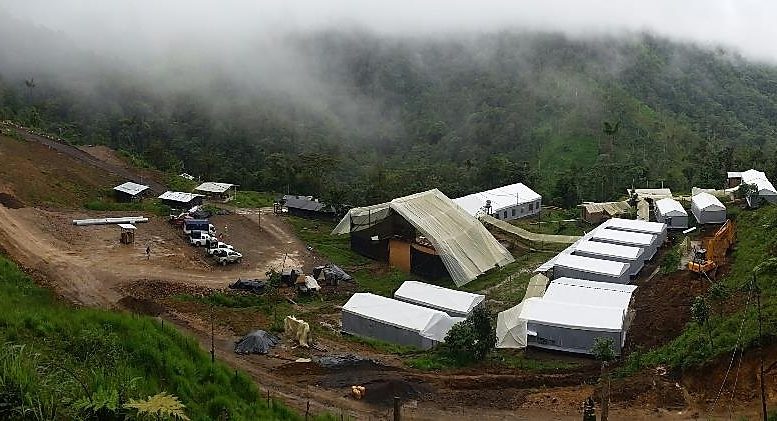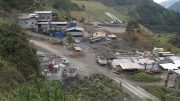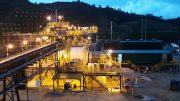VANCOUVER — SolGold (TSX: SOLG; USOTC: SLGGF; LON:SOLG) is building momentum at its 85%-owned Cascabel copper-gold project, 180 km north of Ecuador’s capital Quito. The company expects to ramp up from five to eight drill rigs before delivering its first inferred resource estimate at the property’s Alpala porphyry cluster later this year.
Nicholas Mather, SolGold’s CEO, tells The Northern Miner during a phone interview that drilling has expanded Alpala’s mineralized footprint to 1.3 km along strike and up to 400 metres wide, with depths to 1,900 metres from surface.
Alpala’s entire mineralized trend — as noted from surface work and in geophysical data sets — could total 3 km long, extending from the Moran target in the northwest, to the Cristal target in the southeast.
“There were 28 rigs at Oyo Tolgoi at the peak of their resource drilling activities. We only have five, so we have a long way to go,” Mather says. “This is massive project, and it needs a massive drill program to define its limits and extent. This system is very big and very rich, and we haven’t even found the edges of it.”
Two of SolGold’s drill holes are probing Alpala Central’s northwest and southeast extensions, stepping out on intercepts of 830 metres of 0.63% copper and 0.46 gram gold per tonne, and 586 metres of 0.27% copper and 0.25 gram gold.
Another hole is drilling the Hematite Hill target — a porphyry centre southeast of Alpala Central — after an intercept of 894 metres of 0.78% copper and 0.99 gram gold.
The last two drill holes are testing the eastern extension of Alpala’s high-grade core, where recent drilling hit 770 metres of 0.71% copper and 1.16 grams gold.
“At the moment, the resource program is designed to expand the mineralized shell as far and as wide as we can, so I would hope the resource statement we publish at year-end will cover all the areas we drilled,” Mather says.

SolGold’s chief technical advisor Steve Garwin (centre) reviews core at SolGold’s Cascabel project site. Credit: SolGold.

Benn Whistler, SolGold’s technical services manager, holds a core tray at SolGold’s Cascabel copper-gold project in Ecuador. Credit: SolGold.
SolGold’s technical team is led by chief technical advisor Steve Garwin, who is an authority on porphyry, epithermal and Carlin-style mineralization in the circum-Pacific region.
The company has combined state-of-the-art geophysical techniques with property-wide geochemistry and geology to develop what Mather calls a “low-risk” approach to targeting porphyry systems buried under Ecuador’s jungle.
The model is being updated as higher resolution geophysical surveys and new drill data pour in, Mather adds. So far, the work has outlined 15 porphyry centres and nine priority drill targets at Cascabel, six of which have yet to be tested.
“Drill holes will eventually become a grade-confirmation tool rather than an exploration tool for us — it will be an investment, rather than a speculation,” he says. “We want to show that our exploration is becoming low risk, and that’s important for major investment resource funds to decide whether they should invest in us or not.”
Using the same tools that led SolGold to Alpala, the company intends to explore Ecuador’s part of the central Andean copper belt.
The company has expanded its land position to 1,600 sq. km and outlined 14 project areas. Mather says desktop studies are underway to rank the areas’ prospectivity.

A sample of potassic-altered, diorite outcrop from a new concession at SolGold’s 85%-owned, copper-gold Cascabel project in Ecuador. Credit: SolGold.
“We’re not just building a single project, single deposit company. We’re building a company that has an integrated portfolio of porphyry copper-gold projects through the whole of Ecuador.
“SolGold will become a more attractive investment destination for funds that are interested in the upside of copper, in a team with proven discovery skills, and exposure to a country that has not been subject to the same exploration intensity as the rest of the South American countries,” Mather says.
SolGold has recently listed on the TSX, and Mather says the move is part of the company’s intention to gain access to Canada’s mining and exploration funds, and institutions.
“They’re familiar with the style of mineralization we’re looking at, and understand the growth upside,” Mather says.
Ottawa-based Cornerstone Capital Resources (TSXV: CGP; US-OTC: CTNXF), SolGold’s 15% partner at Cascabel, entered into a lock-up agreement on July 14 with a shareholder that owns 6.8% of SolGold. The agreement means neither party can sell their SolGold shares without the other’s consent. Cornerstone owns 11.23% of SolGold, and notes these two shareholdings combined with its 15% carried interest in Cascabel represent a 30% interest in the Cascabel concession.
Cornerstone also plans to spin off its non-Cascabel assets and rename the company “Cascabel Gold & Copper.”
“Cornerstone is probably trying to build as big as possible an economic interest in Cascabel,” Mather comments. “But the control premium is sound and alive in SolGold. SolGold represents the better value entry into Cascabel, and the only entry into the largest ground position in Ecuador.”
SolGold’s other shareholders include Newcrest Mining (ASX: NCM; US-OTC: NCMGY), 14.5%; DGR Global (ASX: DGR), 13.5%; Guyana Goldfields (TSX: GUY), 8.27%; and Mather, 5.91%.
“I can’t tell you who is going to own SolGold, but what I can tell you is that we’re setting the company on a path towards the discovery, appraisal and development of one of the world’s greatest copper camps.”





Be the first to comment on "SolGold expands Alpala"